The Role of Distribution Forms of Fe–Cr–C Cladding Layer in the Impact Abrasive Wear Performance of Hadfield Steel
Abstract
1. Introduction
2. Materials and Methods
2.1. Experiment Materials
2.2. Experimental Procedures
3. Results
3.1. The Microstructure of the Cladding Layers
3.2. XRD Analysis of the Cladding Layer
3.3. Hardness Distribution
3.4. Wear Performance
3.4.1. Mass Loss
3.4.2. Morphologies of the Worn Surface
3.4.3. Morphologies of the Cross-Section of the Worn Specimens
3.4.4. Wear Mechanism
4. Conclusions
Author Contributions
Funding
Acknowledgments
Conflicts of Interest
References
- Mahlami, C.S.; Pan, X. Challenges and Developments of Hadfield Manganese Steel Castings Based on Service Life. In Proceedings of the 71th World Foundry Congress, Bilbao, Spain, 19–21 May 2014. [Google Scholar]
- Okechukwu, C.; Dahunsi, O.A.; Oke, P.K.; Oladele, I.O.; Dauda, M. Prominence of Hadfield Steel in Mining and Minerals Industries: A Review. IJET 2017, 3, 83–90. [Google Scholar] [CrossRef][Green Version]
- Lencina, R.; Caletti, C.; Brunelli, K.; Micone, R. Assessing Wear Performance of Two High-Carbon Hadfield Steels Through Field Tests in the Mining Industry. Procedia Mater. Sci. 2015, 9, 358–366. [Google Scholar] [CrossRef]
- Deniz, V. A Study on the Effects of Coal Feed Size and Coal Type on the Performance of a Laboratory Jaw Crusher. Energy Sources Part A Recovery Util. Environ. Eff. 2014, 36, 1249–1255. [Google Scholar] [CrossRef]
- Lindroos, M.; Apostol, M.; Heino, V.; Valtonen, K.; Laukkanen, A.; Holmberg, K.; Kuokkala, V.-T. The Deformation, Strain Hardening, and Wear Behavior of Chromium-Alloyed Hadfield Steel in Abrasive and Impact Conditions. Tribol. Lett. 2015, 57, 24. [Google Scholar] [CrossRef]
- Lindqvist, M.; Evertsson, M.; Chenje, T.; Radziszewski, P. Influence of Particle Size on Wear Rate in Compressive Crushing. Miner. Eng. 2006, 19, 1328–1335. [Google Scholar] [CrossRef]
- Unland, G.; Al-Khasawneh, Y. The Influence of Particle Shape on Parameters of Impact Crushing. Miner. Eng. 2009, 22, 220–228. [Google Scholar] [CrossRef]
- Petrica, M.; Badisch, E.; Peinsitt, T. Abrasive Wear Mechanisms and Their Relation to Rock Properties. Wear 2013, 308, 86–94. [Google Scholar] [CrossRef]
- Terva, J.; Teeri, T.; Kuokkala, V.-T.; Siitonen, P.; Liimatainen, J. Abrasive Wear of Steel against Gravel with Different Rock–Steel Combinations. Wear 2009, 267, 1821–1831. [Google Scholar] [CrossRef]
- Xiaofeng, X.; Shengping, Y.; Weixin, Y.; Xiaoguang, Z.; Qiong, X. High Cr White Cast Iron/Carbon Steel Bimetal Liner by Lost Foam Casting with Liquid-Liquid Composite Process. China Foundry 2012, 9, 136–142. [Google Scholar]
- Niu, L.; Hojamberdiev, M.; Xu, Y.; Wu, H. Microstructure and Mechanical Properties of Hadfield Steel Matrix Composite Reinforced with Oriented High-Chromium Cast Iron Bars. J. Mater. Sci. 2010, 45, 4532–4538. [Google Scholar] [CrossRef]
- Okechukwu, C.; Dahunsi, O.A.; Oke, P.K.; Oladele, I.O.; Dauda, M. Review on Hardfacing as Method of Improving the Service Life of Critical Components Subjected to Wear in Service. Niger. J. Technol. 2018, 36, 1095. [Google Scholar] [CrossRef]
- Okechukwu, C.; Dahunsi, O.A.; Oke, P.K.; Oladele, I.O.; Dauda, M. Development of Hardfaced Crusher Jaws Using Ferro-Alloy Hardfacing Inserts and Low Carbon Steel Substrate. J. Tribol. 2018, 18, 20–39. [Google Scholar]
- Mendez, J.; Ghoreshy, M.; Mackay, W.B.F.; Smith, T.J.N.; Smith, R.W. Weldability of Austenitic Manganese Steel. J. Mater. Process. Technol. 2004, 153–154, 596–602. [Google Scholar] [CrossRef]
- Saha, D.C.; Han, S.; Chin, K.G.; Choi, I.; Park, Y.-D. Weldability Evaluation and Microstructure Analysis of Resistance-Spot-Welded High-Mn Steel in Automotive Application. Steel Res. Int. 2012, 83, 352–357. [Google Scholar] [CrossRef]
- Isakaev, E.K.; Mordynskii, V.B. Formation of the Fusion Zone in Plasma Powder Surfacing. Weld. Int. 2010, 24, 540–545. [Google Scholar] [CrossRef]
- Isakaev, E.K.; Mordynskii, V.B.; Tyuftyaev, A.S.; Il’ichev, M.V.; Katarzhis, V.A. Investigation of Plasma-Powder Hardfacing of Hadfield Steel with Impact Treatment. Weld. Int. 2014, 28, 158–162. [Google Scholar] [CrossRef]
- Cao, H.T.; Dong, X.P.; Pan, Z.; Wu, X.W.; Huang, Q.W.; Pei, Y.T. Surface Alloying of High-Vanadium High-Speed Steel on Ductile Iron Using Plasma Transferred Arc Technique: Microstructure and Wear Properties. Mater. Des. 2016, 100, 223–234. [Google Scholar] [CrossRef]
- Chen, H.; Yang, J.; Li, H. Microstructure and Properties of Fe-Based Coatings on Cutting Pick Surface Formed by Plasma Jet Surface Metallurgy. Trans. Nonferrous Met. Soc. China 2009, 19, s583–s586. [Google Scholar] [CrossRef]
- Veinthal, R.; Sergejev, F.; Zikin, A.; Tarbe, R.; Hornung, J. Abrasive Impact Wear and Surface Fatigue Wear Behaviour of Fe–Cr–C PTA Overlays. Wear 2013, 301, 102–108. [Google Scholar] [CrossRef]
- (Jimmy) Jiang, J.; Xie, Y.; Qian, W.; Hall, R. Important Factors Affecting the Gouging Abrasion Resistance of Materials. Miner. Eng. 2018, 128, 238–246. [Google Scholar] [CrossRef]
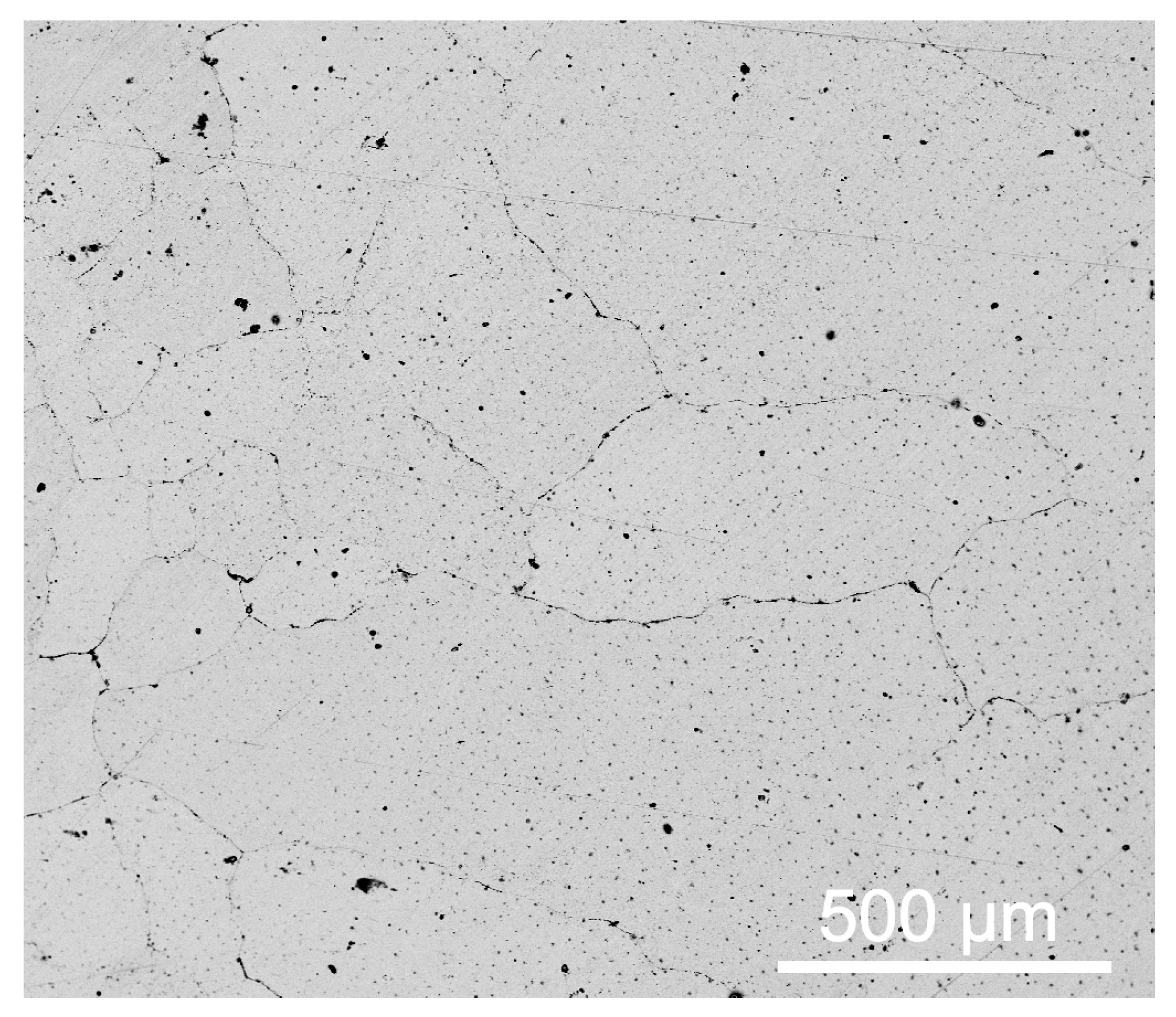
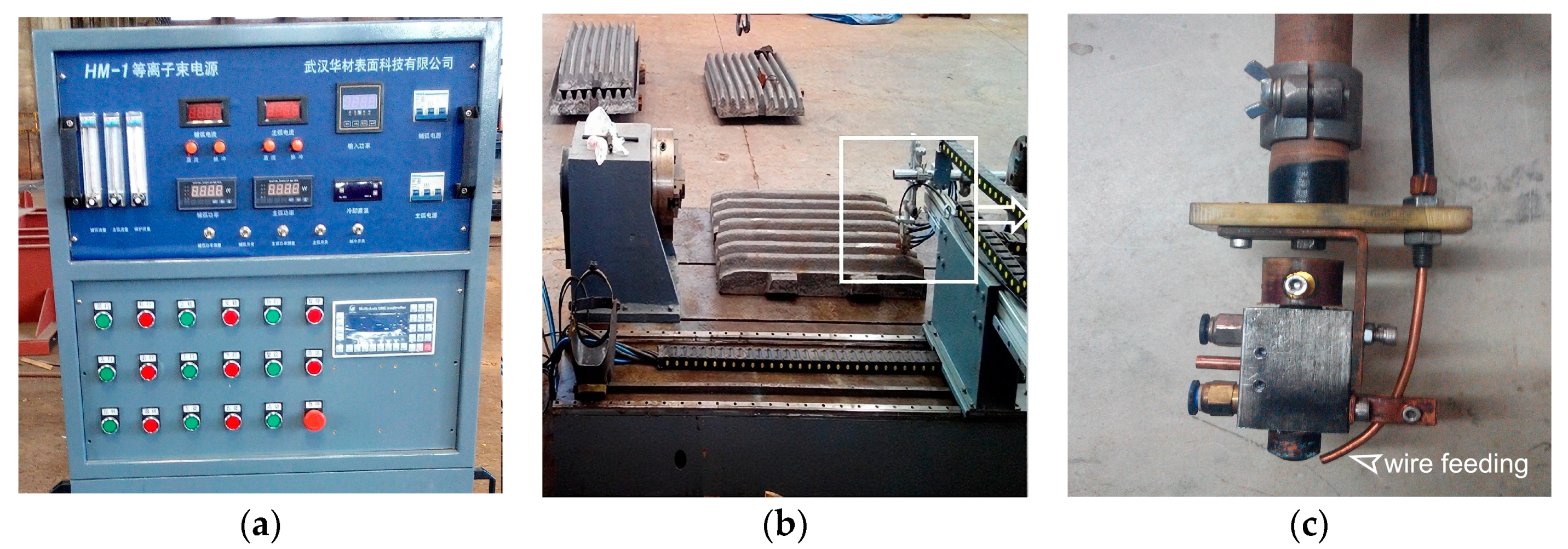
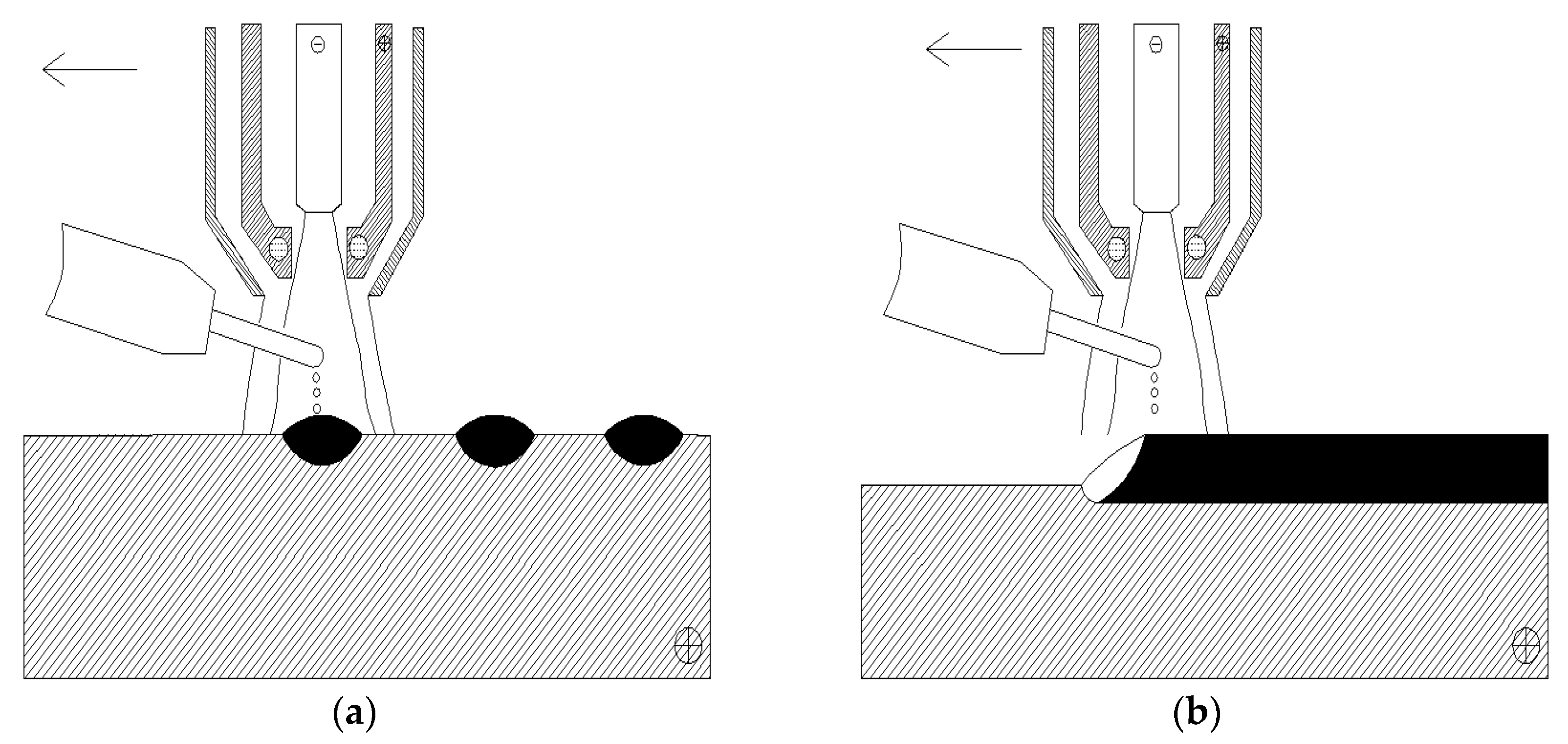
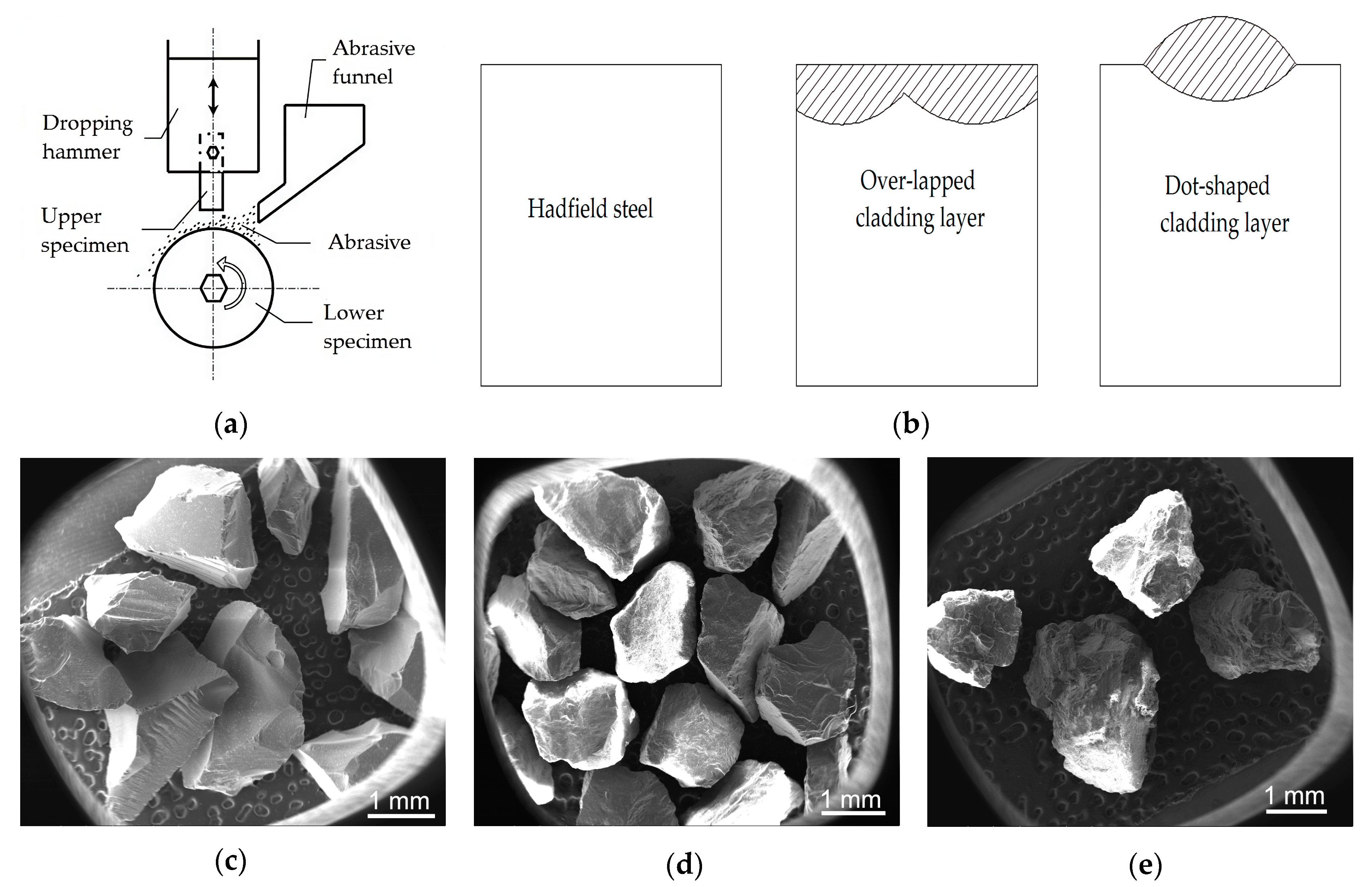
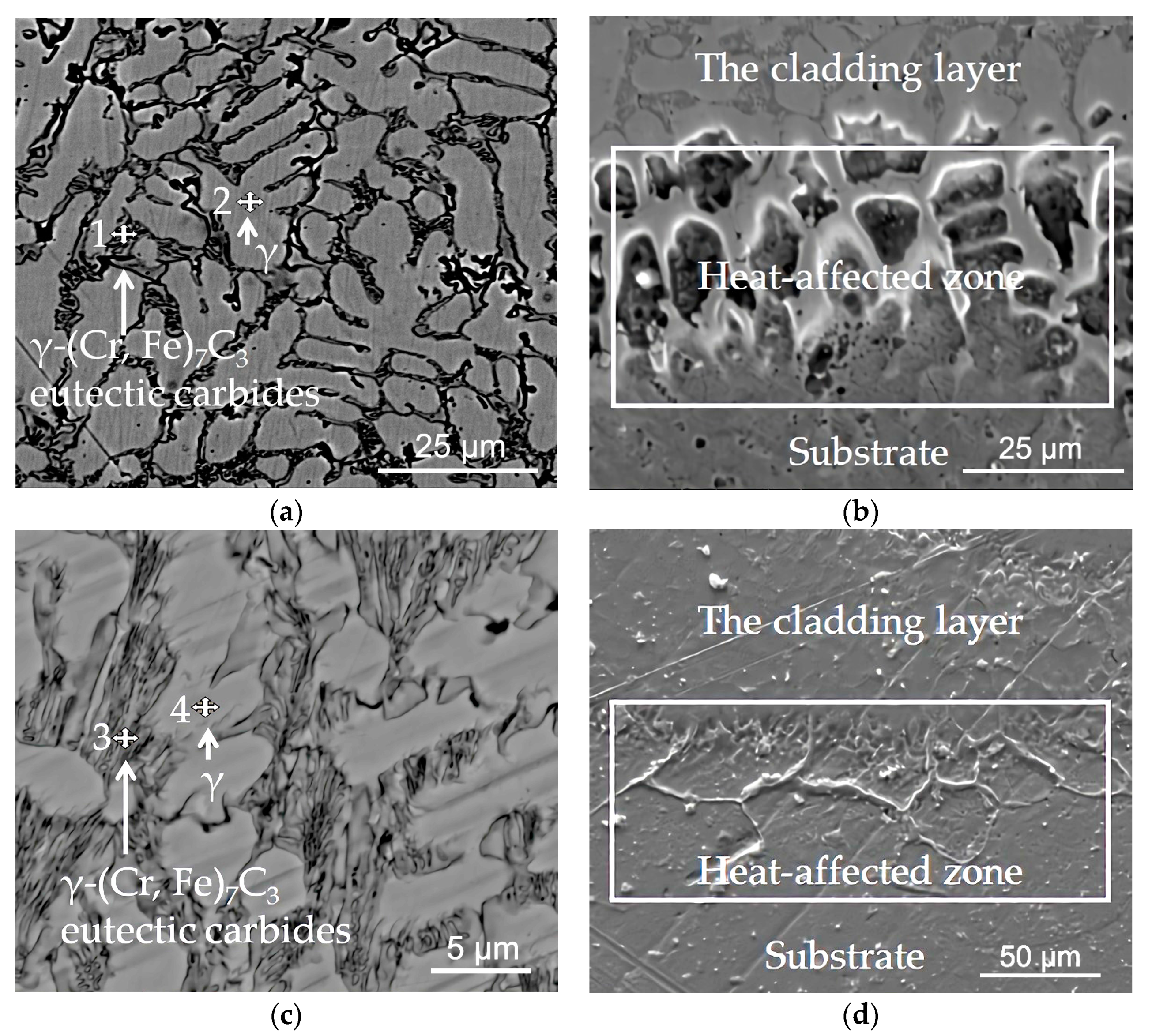
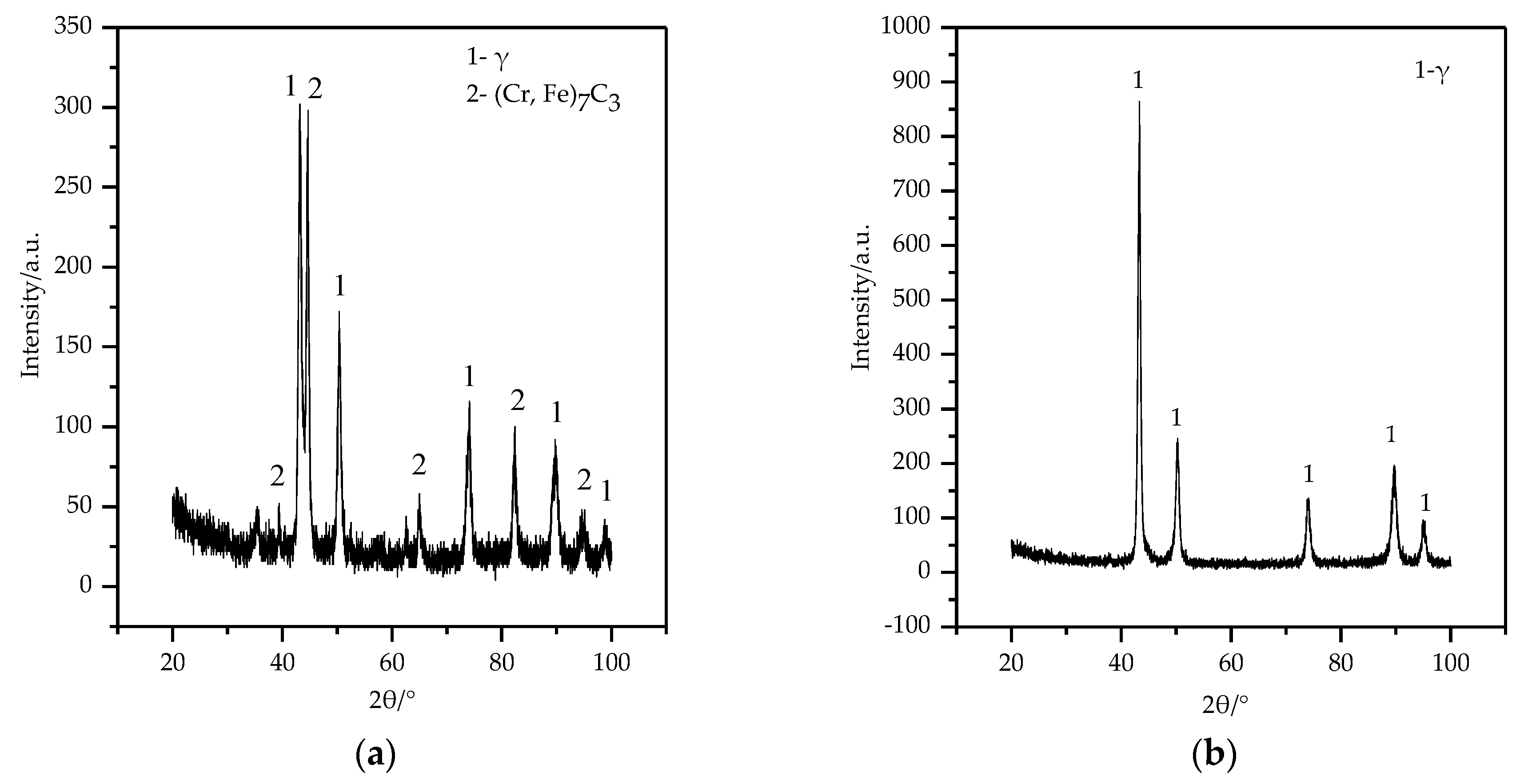
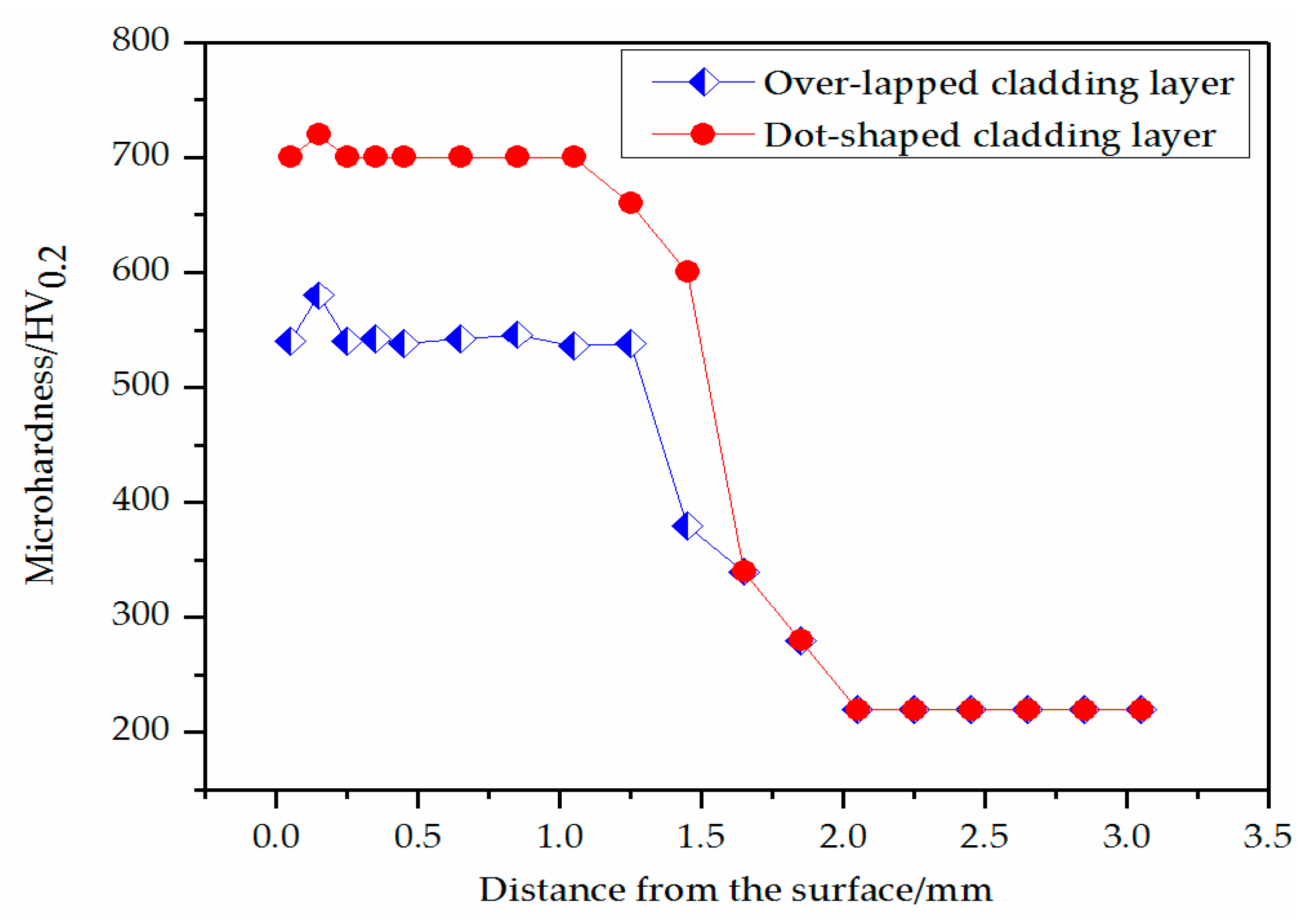
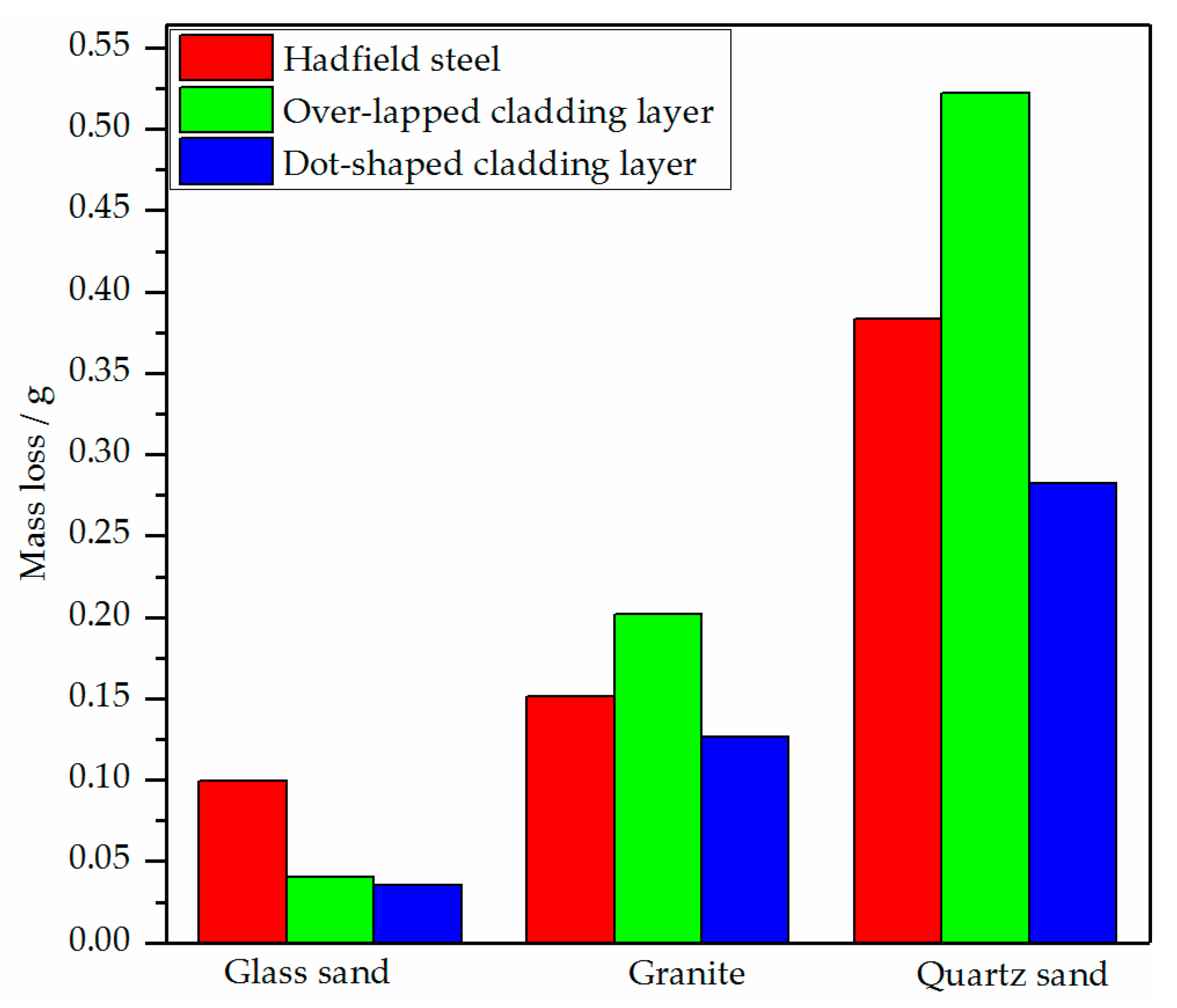
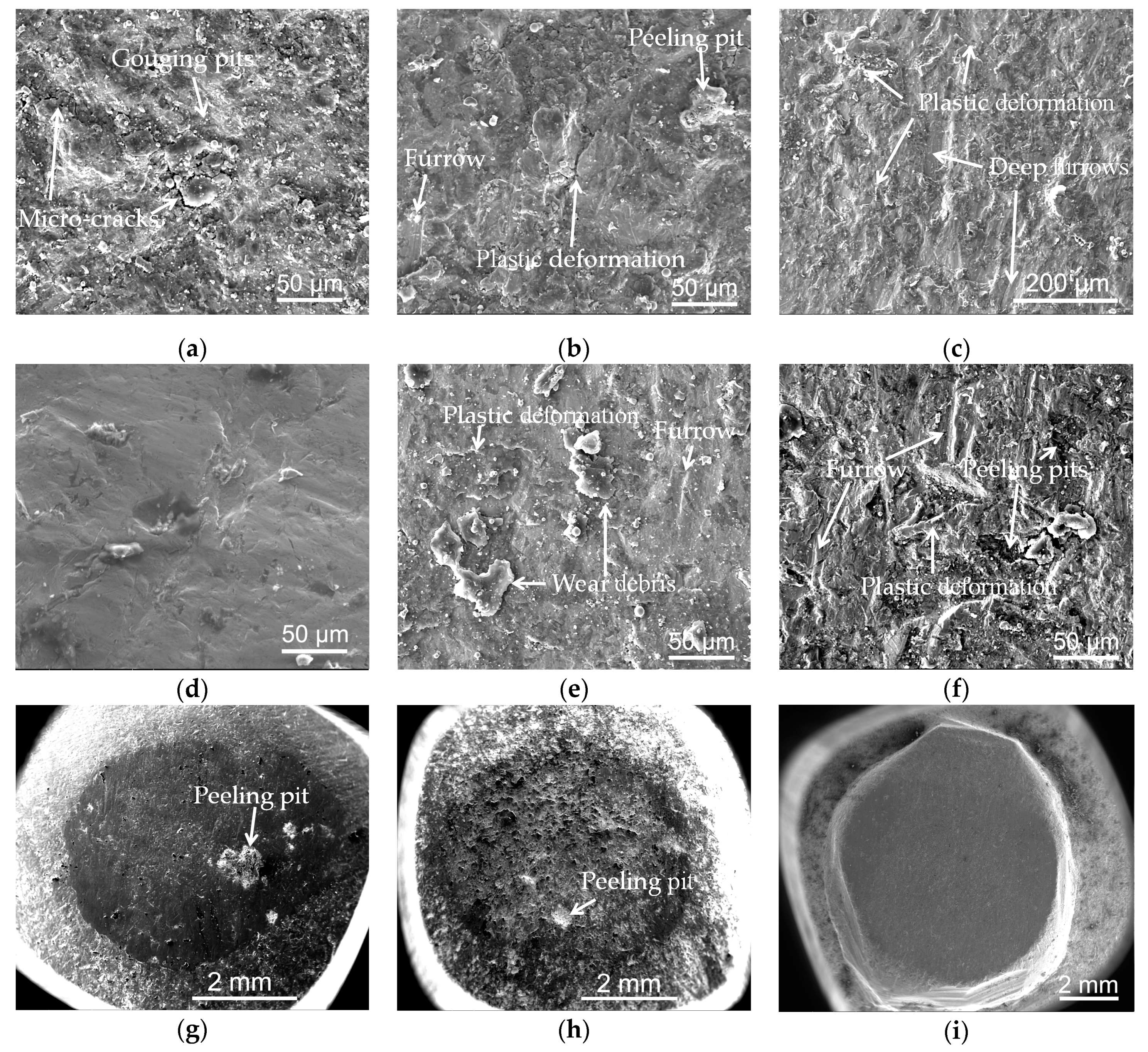


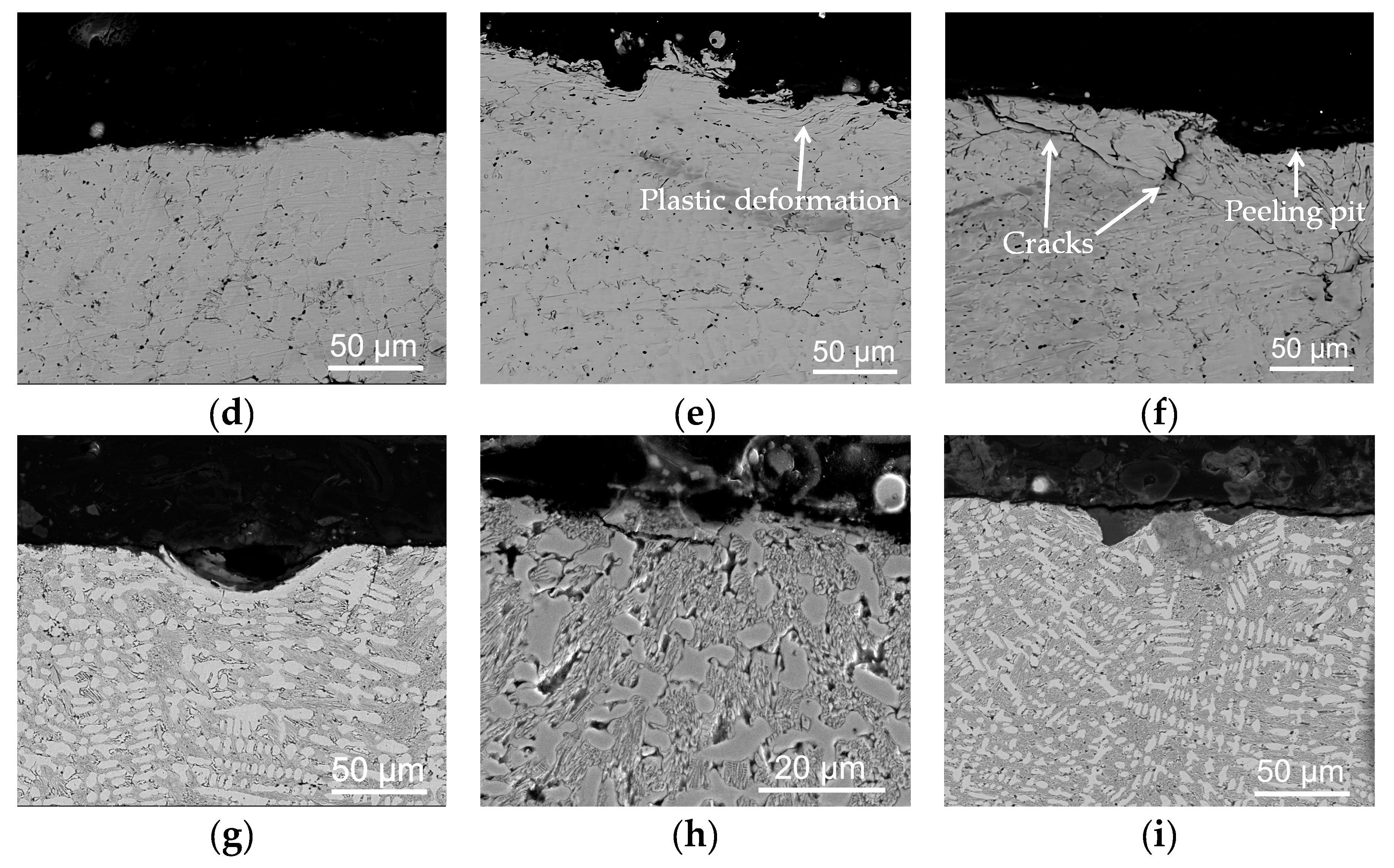
| Materials | C | Si | Mn | Cr | S | P | Fe |
|---|---|---|---|---|---|---|---|
| Hadfield steel | 1.1 | 0.6 | 12.5 | - | <0.05 | <0.03 | Bal. |
| Fe-based wire | 3.5 | 1.2 | 1.5 | 22.5 | - | - | Bal. |
| Parameters | Dot-Shaped Cladding | Over-Lapped Cladding |
|---|---|---|
| Main arc, A | 80 | 120 |
| Torchworking distance, mm | 8 | 8 |
| Wire working distance, mm | 2 | 0.5 |
| The angle between the wire and the component, ° | 20 | 20 |
| Wire feeding speed, mm·min−1 | 800 | 1200 |
| Wire feeding time for per dot-shaped cladding layer, s | 4 | - |
| Plasma gas flow (Ar), L·min−1 | 2 | 2 |
| Shielding gas flow (Ar), L·min−1 | 4 | 4 |
| Plasma torch moving speed, mm·min−1 | - | 800 |
| Over-lapped ratio, % | - | 30 |
| Points | C | Si | Mn | Cr | Fe |
|---|---|---|---|---|---|
| 1 | 16.09 | 0.86 | 6.88 | 14.02 | 62.15 |
| 2 | 12.00 | 1.28 | 8.20 | 11.80 | 66.60 |
| 3 | 24.48 | 1.17 | 04.85 | 16.89 | 52.61 |
| 4 | 09.47 | 1.68 | 04.31 | 09.41 | 75.14 |
| Specimen | Glass Sand | Granite | Quartz Sand |
|---|---|---|---|
| Hadfield steel | Plastic deformation abrasion | Plastic deformation abrasion and plough wear | Plastic deformation abrasion and plough wear |
| Over-lapped cladding layer | Gouging abrasion | Plastic deformation abrasion and plough wear | Plastic deformation abrasion and plough wear |
| Dot-shaped cladding layer | Gouging abrasion | Gouging abrasion | Plough wear |
© 2020 by the authors. Licensee MDPI, Basel, Switzerland. This article is an open access article distributed under the terms and conditions of the Creative Commons Attribution (CC BY) license (http://creativecommons.org/licenses/by/4.0/).
Share and Cite
Pan, Z.; Dong, X.; Cao, H.; Huang, Q. The Role of Distribution Forms of Fe–Cr–C Cladding Layer in the Impact Abrasive Wear Performance of Hadfield Steel. Materials 2020, 13, 1818. https://doi.org/10.3390/ma13081818
Pan Z, Dong X, Cao H, Huang Q. The Role of Distribution Forms of Fe–Cr–C Cladding Layer in the Impact Abrasive Wear Performance of Hadfield Steel. Materials. 2020; 13(8):1818. https://doi.org/10.3390/ma13081818
Chicago/Turabian StylePan, Zhang, Xuanpu Dong, Huatang Cao, and Qiwen Huang. 2020. "The Role of Distribution Forms of Fe–Cr–C Cladding Layer in the Impact Abrasive Wear Performance of Hadfield Steel" Materials 13, no. 8: 1818. https://doi.org/10.3390/ma13081818
APA StylePan, Z., Dong, X., Cao, H., & Huang, Q. (2020). The Role of Distribution Forms of Fe–Cr–C Cladding Layer in the Impact Abrasive Wear Performance of Hadfield Steel. Materials, 13(8), 1818. https://doi.org/10.3390/ma13081818






